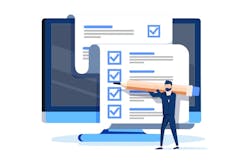In recent columns I have presented ideas for you to consider as you develop your blueprinting standard operating procedure. In the last column I noted that obtaining “repairs and inspections required after a collision” is research job No. 1 for your blueprint SOP. In this column, I want to further explore this essential part of your SOP. Remember that one of the principal objectives of blueprinting is to eliminate preventable supplements, thereby reducing cycle time and increasing customer satisfaction. Researching repairs and inspections required after a collision allows you to itemize and document these operations on your initial repair plan instead of waiting until the end of the repair to address these knowable items.
How do you find these procedures? The best way, as we discussed previously, is to utilize the manufacturers’ technical information website or workshop manual. A good place to look for these operations is in the “general guidelines” section of the OEM site or in the “supplemental restraint systems” section of the OEM site.
We repair a lot of Subarus in our market, so let me share an example of their inspection requirements. Do not make the mistake of thinking that these procedures apply universally. Be sure to look up the procedure for the specific vehicle you are working on by using the VIN search method if it is available.
The location of the Subaru inspection procedure is pretty straight forward: It is found in the manual under “Air bag Systems> Inspection Locations after a Collision” and stipulates the following instructions:
If the vehicle is involved in a collision, even if it is a slight collision, be sure to check the following systems.
- Frontal collision (driver’s air bag module not activated)
- Visually inspect the following items and replace any damaged or cracked part with a new one.
- Specially inspect the damage of air bag module body, mounting bracket and harness connector.
- Driver’s air bag module
- Passenger’s air bag module
- Seat cushion air bag module
- Seat belt pretensioner (right and left)
- Front sub sensor (right and left)
- Instrument panel assembly (because it is integrated with passenger’s airbag module)
When we encountered these instructions, we read and re-read them trying to be sure we interpreted them correctly. It seemed clear to us that even if the driver’s air bag didn’t deploy, we needed to remove the complete air bag modules from the vehicle to inspect the air bag itself, the mounting bracket and the wire harness connector. In order to be sure we were correct, we contacted the director of the Subaru certified collision repair program and asked for confirmation. He checked with the Subaru engineers in Japan and said the procedures as listed in the Subaru Technical Information System (STIS) are to be followed exactly. When we asked if the procedures required the removal of the air bag modules in order to inspect the wire harness connectors and the body of the module, we were told that removal would be required unless we could see the complete module “in situe.” Well, our borescopes can’t see all the way around some of the modules and we lack X-ray vision, so we have no choice but to remove the modules to correctly complete the inspection procedure.
Are you and your blueprinter aware of these required procedures from Subaru? Are you aware of the inspections and replacements required if the driver’s air bag did deploy? Take a look at this list and note the underlined items that most shops are not aware of:
Frontal collision (driver’s air bag module assembly activated)
- 1. Replace the following parts with new ones:
- Air bag control module
- Driver’s air bag module
- Passenger’s air bag module (if deployed)
- Seat cushion air bag module
- Side air bag module (right and left / if deployed)
- Curtain air bag module (right and left / if deployed)
- Seat belt pretensioner (right and left)
- Front sub sensor (right and left)
- Instrument panel assembly (because it is integrated with passenger’s air bag module) (if passenger’s air bag module is deployed)
- Steering wheel
- Column assembly - steering
- Roll connector
- Pad assembly - front seat backrest (if the side air bag is deployed)
- Frame assembly - front seat cushion (if the side air bag is deployed)
- Frame assembly - front seat backrest (if the side air bag is deployed)
- Cover COMPL - front seat backrest (if the side air bag is deployed)
- Trim panel - roof assembly (if the curtain air bag is deployed)
- Trim panel of each pillar (if the curtain air bag is deployed)
- 2. Visually inspect the following items and replace any damaged part with a new one:
- Universal joint - steering
- Steering gearbox
- Beam COMPL - steering
- Harnesses and connectors on body side that are linked to the replaced parts
Okay, you’re thinking, “Wow, that’s a lot of operations to complete with or without an air bag deployment!” and you are correct. You might also think that Subaru is probably the only OEM that requires such an extensive inspection procedure. Please allow me to challenge you to look up the required inspection procedures for any Toyota vehicle (probably one of the most ubiquitous vehicles in your shop) per the “Supplemental Restraint System: Air bag System: Precaution” section of the Toyota Information System (TIS). Find the list of components that require inspections and possible replacement after a collision. When you drill down further on the actual procedure for the inspections, you’re likely to find that the directions specifically state the components must be removed from the vehicle to do the inspection. I can hear all the “wow’s” right now. Yes, in many cases, Toyota expects you to remove every air bag (including side curtains) and do a complete inspection. Nissan requirements are surprisingly similar. Now, go check out GM and Ford requirements.
I’ve experienced numerous challenges from third-party payers of claims who did not believe we are required to do these inspections. Even though we provided the written documentation from the OEMs, some went so far as to call local dealerships and they were given erroneous information that the inspections weren’t necessary, or that they’d never heard of such a thing. Well, the best way to prevent that is to go to the dealerships and educate the service manager and service writers using their own technical service procedures as guidance. The other thing we do is occasionally sublet some of these inspections to the dealership so that the procedures are fresh in their minds should someone make an inquiry about them.
So, I hope you can see the importance of incorporating the research of required inspections after a collision into your blueprinting process. On a side note, we’ve asked some of our local dealers how many shops have the dealer do the required inspections. The answer was zero, which is alarming but not wholly unexpected. The question I have for you is: Will you be doing these inspections going forward?
About the Author

Steve Morris
The late Steve Morris was the regional director for Classic Collision in California (formerly Pride Collision Centers). He was an Accredited Automotive Manager (AAM) and ASE-certified master technician. Morris died April 22, 2022, at the age of 63 of complications following surgery.
